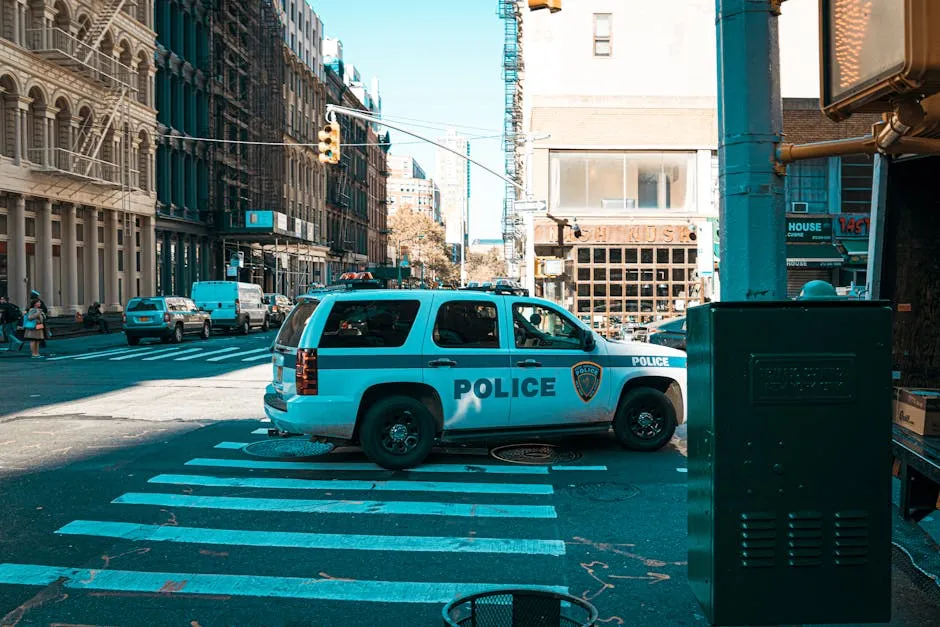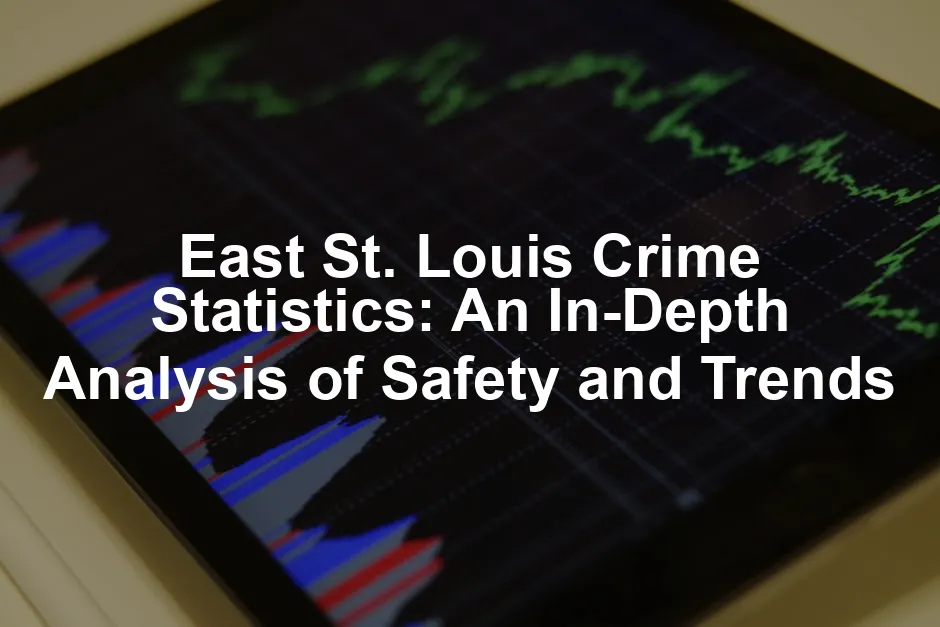Introduction
East St. Louis, Illinois, often finds itself in conversations about crime. This city has gained notoriety for its high crime rates, especially in violent offenses. It’s essential to discuss these statistics to inform residents, potential visitors, and policymakers. Understanding crime data helps everyone navigate safety concerns and make informed decisions.
For residents, knowing local crime patterns can lead to better personal safety measures. Visitors should be aware of the potential risks when traveling to East St. Louis. Policymakers can utilize these statistics to guide resource allocation and community programs aimed at improving safety.
This article aims to provide a thorough analysis of crime statistics in East St. Louis. We will cover essential definitions, analyze trends, compare local data to national averages, and discuss safety measures currently in place. It’s crucial to understand that while the statistics paint a grim picture, they can also highlight areas needing attention and improvement.

Understanding Crime Statistics
What are Crime Statistics?
Crime statistics are numerical data that represent occurrences of criminal offenses in a specific area. They are vital for assessing community safety and can guide law enforcement and community initiatives. By understanding these figures, stakeholders can identify crime trends and allocate resources effectively.
There are two primary types of crimes measured: violent crimes and property crimes. Violent crimes include offenses such as murder, assault, and robbery. These crimes directly threaten personal safety and well-being. Property crimes, on the other hand, involve theft or damage to someone’s belongings, like burglary and auto theft. Both categories play a significant role in overall crime statistics and community perceptions of safety. To further understand the dynamics of violent crime, consider reading Crime and Punishment by Fyodor Dostoevsky. It’s a classic that dives deep into the psychological effects of crime.

Data Sources & Methodology
Crime data in East St. Louis primarily comes from local law enforcement agencies and the FBI. The FBI compiles these figures from over 18,000 law enforcement agencies across the country. The data reflects incidents reported during the 2022 calendar year, making it a crucial resource for understanding the current state of crime.
To ensure accuracy, crime data is normalized for comparative analysis. This means adjusting figures based on population size and other factors, allowing for a fair comparison with other cities. By evaluating these statistics, we can gain insight into East St. Louis’s safety landscape and see how it stacks up against national averages.
In conclusion, understanding crime statistics is crucial for fostering a safer community. By examining these figures, we can identify trends, inform residents and visitors, and encourage proactive measures to improve safety in East St. Louis. For a deeper dive into crime statistics, you can refer to the Fremont Crime Statistics.
Understanding crime statistics is essential for community safety. Fremont crime statistics can provide additional insights.
Overview of Crime in East St. Louis
Current Crime Rates
East St. Louis has a reputation that precedes it, particularly when it comes to crime. As of the latest data, the total crime rate stands at approximately 38.45 per 1,000 residents. This number is alarmingly high compared to national averages. The violent crime rate is recorded at 11.33 per 1,000, while property crime rates soar to 27.12 per 1,000 residents.
When we dig a little deeper, specific crime statistics reveal even more concerning trends. In the past year, East St. Louis reported 203 violent crimes, including 36 homicides. That’s a staggering homicide rate of approximately 137 per 100,000 residents. For context, the national average for homicide is just 6.1 per 100,000. Other violent crimes include assaults, which are significantly higher than the national average, showing the urgency for community safety measures.
Property crimes are no less troubling, with 486 incidents recorded last year. This includes thefts, burglaries, and motor vehicle thefts, which have become increasingly frequent. The property crime rate in East St. Louis stands at about 27.12 per 1,000 residents, far exceeding the Illinois state average of 16.83 and the national average of 20.
In summary, the crime statistics for East St. Louis paint a daunting picture. The odds of becoming a victim of a violent crime are approximately 1 in 88, while property crimes present an even greater risk, with chances at 1 in 37. These figures highlight the urgent need for community awareness and proactive measures. If you’re interested in understanding more about crime and societal issues, consider picking up The New Jim Crow by Michelle Alexander. It provides insight into the systemic issues surrounding incarceration.

Historical Trends
Looking at the historical trends, the crime landscape in East St. Louis has seen fluctuations over the last decade. In recent years, there has been a noticeable decrease in violent crime. For instance, homicides have dropped by 31% over the last four years, indicating progress towards safety improvements. Still, the overall crime rates remain stubbornly high.
To visualize these changes, we can look at a chart displaying the violent crime rates from 2010 to 2022. In 2010, the violent crime rate was alarmingly high at around 5,825 per 100,000 residents. Fast forward to 2018, and it had decreased to about 1,190 per 100,000, reflecting a significant decline. Yet, despite this positive trend, East St. Louis still ranks among the most dangerous cities in the United States.
Across the last decade, property crimes have also shown a downward trend, although they still remain above the national average. This drop in crime rates can be attributed to various law enforcement initiatives aimed at community engagement, such as the Public Safety Enforcement Group formed in collaboration with local organizations.
In summary, while the recent trends show promise, East St. Louis continues to face significant challenges regarding crime. Continuous efforts and community involvement are essential to maintain and enhance this positive momentum. If you’re intrigued by the psychology behind crime, check out The Sociopath Next Door by Martha Stout. It dives deep into the minds of those who commit crimes.

Violent Crime Comparisons
East St. Louis has a reputation for high violent crime rates. When we compare its statistics to Illinois state averages, the differences are striking. The violent crime rate in East St. Louis stands at 11.33 per 1,000 residents. In contrast, the Illinois median is just 2.87 per 1,000. That’s a whopping 295% increase!
Now, let’s take a look at national averages. The U.S. average for violent crime is around 4 per 1,000 residents. This means East St. Louis’s rate is nearly three times higher than the national average! Such figures highlight a significant disparity, underscoring the urgent need for community safety efforts. For those interested in exploring the societal implications of violence, Steven Pinker’s The Better Angels of Our Nature is a must-read.

Property Crimes in Detail
Types of Property Crimes
Property crimes encompass various offenses, such as burglary, theft, and auto theft. In East St. Louis, the property crime rate is alarmingly high at 27.12 per 1,000 residents.
Burglary is one of the most prevalent issues. Last year, there were 643 reported burglaries, reflecting a worrying trend. Theft is also rampant, with notable incidents of larceny. Auto thefts have become increasingly common, with a staggering one in 81 residents facing the risk of having their vehicle stolen.

Property Crime Comparisons
When we compare property crime rates, East St. Louis stands out. The property crime rate here is significantly higher than that of Illinois, which averages 16.83 per 1,000. Nationally, the average is 20 per 1,000 residents. East St. Louis exceeds both, showing a 66% increase over the state average and 35% over the national average. This paints a concerning picture of safety in the city. For those interested in enhancing personal safety, a Personal Safety Alarm Keychain can be a vital tool for alerting others in emergencies.

Neighborhood Safety Insights
Safest Neighborhoods in East St. Louis
Despite the overall high crime rates, some neighborhoods in East St. Louis have lower crime statistics and offer a semblance of safety.
- Edgemont: This neighborhood boasts a tight-knit community and active neighborhood watch programs. Residents often report feeling safer due to strong community ties.
- Southend / Franklin Park: Known for its friendly atmosphere, this area has seen residents band together to reduce crime. Their efforts have led to a noticeable decline in incidents.
- Claremont / Fairlawn: With an increased police presence, this neighborhood has benefited from proactive law enforcement strategies, making it one of the safer areas in East St. Louis.
- Wedgewood / Dayton: This area has a lower crime rate, attributed to community initiatives that promote safety and neighborhood engagement.
- Goose Hill / Emerson Park: Residents here have taken an active role in maintaining safety, fostering a sense of security.
These neighborhoods illustrate that, while East St. Louis faces significant challenges, community involvement and engagement can lead to safer environments. Residents in these areas exemplify the power of collaboration and vigilance in combating crime. If you’re considering enhancing your home security, a Home Security Camera System could be a wise investment.

Recent Developments and Future Outlook
Crime Reduction Initiatives
In a city often overshadowed by its crime statistics, initiatives aimed at crime reduction are shining a much-needed light of hope. The Public Safety Enforcement Group (PSEG) is at the forefront of these efforts. Formed in collaboration with the Illinois State Police and local law enforcement, PSEG has made significant strides in tackling violent crime.
In 2023, the group increased the homicide clearance rate by 29% compared to the previous year. This means more cases are being solved, which can deter potential offenders. PSEG has also seized nearly 500 firearms and 200 pounds of illegal drugs. Community engagement is a crucial part of this strategy, as local organizations work alongside law enforcement to enhance safety.
Additionally, the city has implemented multi-day patrol operations in high-crime areas. These operations involve collaboration among over 140 officers from different regions, targeting organized crime and violent offenders. The increased visibility of law enforcement has led to a significant decrease in incidents such as carjackings, auto thefts, and home burglaries. This proactive approach is crucial in reinforcing community trust in law enforcement.
Moreover, the partnership with community organizations allows for a holistic approach to crime reduction. For instance, the involvement of schools and faith-based organizations has resulted in tangible support for families affected by crime, further fostering a sense of safety within the community. For those looking to secure their homes, consider investing in a Smart Doorbell Camera for added security.

Future Trends
Looking ahead, East St. Louis is positioned at a crossroads. On one hand, there is a promising trend of declining violent crime rates. Homicides have dropped 31% over the past four years, indicating that the initiatives are yielding positive results. However, challenges remain. The stigma associated with the city’s crime rates can deter investment and community engagement.
As new data emerges, it’s essential to focus on sustaining and expanding these successful initiatives. Continued collaboration between law enforcement and community stakeholders will be vital for maintaining momentum. The effectiveness of programs like PSEG depends on their adaptability and responsiveness to emerging crime trends.
Potential opportunities lie in technology utilization, such as the installation of surveillance cameras and improved data analysis methods. These advancements can enhance law enforcement’s ability to anticipate and respond to crime effectively. If you’re considering a comprehensive approach to safety, an Emergency Survival Kit can be a great addition to your safety measures.
However, challenges persist, particularly in addressing underlying issues like poverty and lack of access to education. Without tackling these root causes, crime reduction efforts may achieve only limited success. The community must remain engaged and proactive in advocating for resources and programs that address economic disparities.
In conclusion, East St. Louis stands at a pivotal moment. While recent trends suggest progress in crime reduction, the journey toward a safer community requires ongoing commitment, innovative strategies, and a unified approach. By fostering stronger ties between law enforcement and residents, there’s potential to transform East St. Louis into a place where safety and community thrive together.

Conclusion
In our exploration of East St. Louis crime statistics, some key findings emerge. The city has grappled with notably high crime rates, particularly in violent and property crimes. Recent data reveals a total crime rate of approximately 38.45 per 1,000 residents, with a staggering violent crime rate of 11.33 per 1,000. Specific figures, like a homicide rate of 137 per 100,000, starkly contrast with national averages of 6.1. These statistics highlight the urgent safety concerns faced by residents and visitors alike.
However, there are glimmers of hope. Over the past few years, crime rates have shown signs of decline, particularly in homicides, which decreased by 31%. This positive trend reflects the effectiveness of community initiatives and law enforcement collaboration through groups like the Public Safety Enforcement Group. Their efforts have led to increased visibility of police presence and community engagement, fostering a safer environment.
It’s essential to recognize the ongoing need for monitoring these trends. Crime statistics should not be viewed as static; they require constant attention. Community involvement plays a vital role in crime reduction. Residents can contribute by participating in neighborhood watch programs and engaging with local law enforcement to address issues directly affecting their safety.
For those looking to stay informed about safety in East St. Louis, several resources are available. Local law enforcement websites provide updates on crime trends and safety initiatives. Additionally, community organizations often host events aimed at fostering dialogue between residents and police, enhancing mutual understanding and cooperation.
Residents and visitors should continue to exercise caution while remaining vigilant. By staying informed and involved, they can contribute positively to the ongoing effort to make East St. Louis a safer place for all. And while you’re at it, why not indulge in a little self-care with a Noise-Canceling Headphones? They can help you escape the chaos while you read up on these statistics!

FAQs
Please let us know what you think about our content by leaving a comment down below!
Thank you for reading till here 🙂
All images from Pexels




